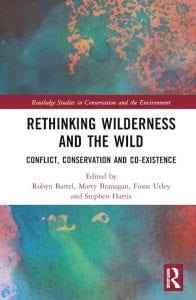Image: UNE editors and contributors to Rethinking Wilderness and the Wild present their work at the 23rd International Symposium on Society and Resource Management in Umeå, Sweden. Left to right: Fiona Utley, Tanya Howard, Robyn Bartel, Vanessa Bible.
Sustainability, biodiversity, climate change, nature conservation, and more broadly the relationship between humans and our environment, are all topical areas for research and increasingly benefitting from multi- and inter-disciplinary investigation. It is more widely appreciated that humans are at the heart of conservation questions and that the humanities and social sciences are as important as the sciences in providing answers and solutions.
With around 40 members across multiple disciplines within the Schools of HASS and Education within HASSE, and cross-faculty, including Psychology, Law, Business, and ERS, the interdisciplinary community of researchers known as the Environmental Humanities Research Network (EHRN) understand this perfectly. EHRN aims to provide thought leadership in this critical space — think climate change, the biodiversity crisis and the ongoing challenges of environmental justice.
EHRN’s goal is to work toward delivering public good outcomes through creating and sharing knowledge to enable resilience and an innovative, sustainable and just society. As well as addressing climate change, biodiversity loss, land and water degradation, EHRN are also focused on supporting the UN Sustainable Development Goals, including peace and social justice, and a more inclusive and caring environment for all. And, as EHRN notes on their webpage, ‘UNE is uniquely situated, both geographically and intellectually, to engage with environmental concerns that have serious implications for the wellbeing of our region, as well as far-reaching national and global consequences’.
EHRN has several notable achievements under its belt, including attracting nationally competitive grant funding and working with local and regional communities on novel and innovative ways to build understanding and resilience. Many of their projects have emerged from collaborations which have been staged in such a way as to gather and gain momentum and focus interest around core topics.
One of their most recent outputs is a great example of this. Several years ago, members of EHRN were motivated to commemorate the anniversary of a well-known and highly regarded UNE publication, Wilderness in Australia: Eastern New South Wales and South-Eastern Queensland published in 1976 by UNE academics Peter Helman, Alan Jones, John Pigram and Jeremy Smith. Wilderness in Australia became a pivotal text in nature conservation (see for example discussion in Peter Prineas’ Wild Places, Southwood Press, 1997). Wilderness in Australia was aimed at making a contribution both academic and practical in the policy space and was enormously successful, generating an almost immediate response. It galvanized public support, advocacy and activism for environmental conservation, and its recommendations were adopted in wilderness legislation and policy throughout Australia, leading to the declaration and protection of numerous areas over several decades.
In the hope of mirroring the quality and impact of such a contribution, and also to interrogate the many questions in wilderness conservation that have emerged and become more salient since 1976, and especially First Nations’ co-creation of so-called ‘pristine’ and ‘untouched’ landscapes, as well as the growing tensions between different intellectual camps and agendas, EHRN crafted a plan. EHRN developed a book proposal to showcase works from UNE academics and leading researchers across Australia exploring interdisciplinary understandings of the social and environmental definitions of nature and wilderness as well as applications in policy and conservation. A UNE symposium harvested local contributions and international conference presentations (see Figure) led to the ‘recruitment’ of scholars from as far afield as Iceland, thereby creating a global initiative.

Rethinking Wilderness and the Wild: Conflict, Conservation and Co-existence, published by Routledge in 2021, is the culmination of all of these EHRN efforts, and is emblematic of the network’s philosophy. One of the central purposes of the book is to elevate our understanding and appreciation of the interrelationships between human and nature and the importance of multi-disciplinarity and the environmental humanities in global discussions around wilderness and nature. The anthology showcases multi-disciplinary research from across UNE, from geography to English literature, psychology to peace studies, history to sociology, as well as leading lights from beyond UNE, including Freya Mathews, Brendan Mackey and Tao Orion. Several chapters have been selected to be showcased on Sustainable Development Goals Online. Invited to nominate a favourite the editors highlight a chapter and poem by Lorina Barker which provides a fitting conclusion to the collection.
If you would like to join us for the book launch, please SAVE the DATE: 9 December 2021 at Oorala, UNE. COVID-19 permitting we will hold an in-person celebration of the book, host a panel session on book publishing and editing for ECRs and MCRs, and also scope our next book project: Environmental Philosophy and Sustainable Peace, as a curtain-raiser for Peace Studies’ 40th Anniversary in 2022.
If you would like to be a part of things (and who wouldn’t?!) please email the coordinator of EHRN, Associate Professor Robyn Bartel rbartel@une.edu.au
If you would like to find out more about EHRN and their fantastic work, follow the link here.



Recent Comments